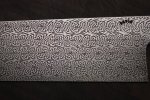kuraki
Fimbulvetr Knifeworks
- Joined
- Jun 17, 2016
- Messages
- 4,679
I've been prepping some bars to attempt a turkish twist for the first time. I understand the basics from watching Jerry Fisk's videos and Manuel Quiroga's videos, basically:
-weld 4 layered bars and forge down square
-twist 2 cw, 2 ccw
-square up twists again
-stack and weld alternating twists
-cut relief before forming tip so bars stay paralell with edge
-don't forge to shape but use finished billet and do stock removal to get to center pattern
I'm pretty confident in my ability to do all those things, except I still have some problems with twists, specifically after twisting you have essentially a thread form, where the edges of the square bar become the crests of the thread. When doing a simple twist that I intend to be the final pattern, I start with a rather large bar because I have poor luck getting these thread forms to weld to each other, and when I draw out the twisted bar, it sometimes ends up with splits across the twist and jagged edges.
In Manuel's video, after twisting, he squares up the twist in square dies, which I think would help that problem, so I'm going to make another smaller set just for this, but I'm hoping someone could explain how they get repeatably good results from twisting, since I can't tell why half the time get good results with little lost material in the crests and the other half end up with cold shut splits halfway through my billet.
To date I've been twisting in a vise with a pipe wrench but will be making a manual twisting jig for this, with the intent of upgrading it to run off a motor and gear reducer I have laying around in the future.
-weld 4 layered bars and forge down square
-twist 2 cw, 2 ccw
-square up twists again
-stack and weld alternating twists
-cut relief before forming tip so bars stay paralell with edge
-don't forge to shape but use finished billet and do stock removal to get to center pattern
I'm pretty confident in my ability to do all those things, except I still have some problems with twists, specifically after twisting you have essentially a thread form, where the edges of the square bar become the crests of the thread. When doing a simple twist that I intend to be the final pattern, I start with a rather large bar because I have poor luck getting these thread forms to weld to each other, and when I draw out the twisted bar, it sometimes ends up with splits across the twist and jagged edges.
In Manuel's video, after twisting, he squares up the twist in square dies, which I think would help that problem, so I'm going to make another smaller set just for this, but I'm hoping someone could explain how they get repeatably good results from twisting, since I can't tell why half the time get good results with little lost material in the crests and the other half end up with cold shut splits halfway through my billet.
To date I've been twisting in a vise with a pipe wrench but will be making a manual twisting jig for this, with the intent of upgrading it to run off a motor and gear reducer I have laying around in the future.







